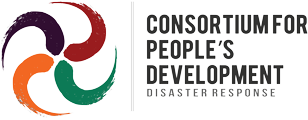Since 2013 consecutive typhoons left massive damages in the Philippines; starting from Yolanda (Haiyan), the strongest typhoon ever recorded to hit, followed closely by Typhoon Glenda (Ramassun) in 2014. Both forces led to massive losses in agriculture, housing, and other infrastructures leaving many communities distraught, including Quezon Province. In response to this, the Southern Tagalog People’s Response Center—a community-based disaster management NGO that has been extending service and support to people and communities most vulnerable to disasters—conducted relief delivery operations (RDOs) with the help of various people’s organizations (POs) to 30 barangays from 12 municipalities in Quezon including Catanauan.
In December 6, 2014, another typhoon—Typhoon Ruby (Hagupit), ravaged through Southern Tagalog affecting many farming and fishing communities. Many people anticipated Typhoon Ruby with dread, terrified that it may be another huge disaster. Hence, preemptive and forced evacuations were conducted especially in communities where it was expected to pass. A total of 12,970 families were affected by Typhoon Ruby. In Catanauan, Quezon electric power was interrupted by strong winds and rain affecting 647 families. Agricultural crops, which have not yet recovered from Typhoon Glenda (Ramassun) the previous year, were, again, damaged. Due to the relatively slow movement of Typhoon Ruby, tremendous rainfall and wind affected the main crops of the farmers. Families also stayed longer—five days—in evacuation centers and fisherfolk had no catch.
With assistance from the National Alliance for Filipino Concerns (NAFCON), a national multi-issue alliance of Filipino organizations and individuals in the United States, and CPD-DR, STPRC launched the TYPHOON RUBY REHABILITATION PROJECT which not only focused on emergency response but in equipping the target beneficiaries with knowledge on disaster preparedness and providing livelihood aid towards building disaster-resilient communities.
The project ran for six months and benefitted at least a hundred and sixty-six (166) farmers and fisherfolk in Catanauan, Quezon. They conducted vegetable seeds and farm tools dispersal as well as provided fishing gear support to augment livelihood. At the end of the project, the beneficiaries were able to plant and grow the distributed packs of assorted vegetables. The hook-and-lines distributed were actively used in fishing. Each time the fishermen sell their fish catch, they purchase new materials such as nylons and hooks.
Aside from that Disaster Management Orientations (DMO) and Disaster Preparedness Trainings were also held wherein majority of the participants did not have prior trainings or seminars related to disasters. Soon after, the communities recognized the necessity of disaster management in their community due to the multiple hazards in their community such as typhoons, flooding, landslide, storm surge, tsunami, earthquake, and drought. The participants also acknowledged the need to organize Disaster Preparedness Committees in their community to increase their capacity to prepare and respond to disasters since DRR efforts from the local government is inadequate as experienced during Typhoon Glenda and Typhoon Ruby. A total of 15 Disaster Preparedness Committees (DPC) were also established at the community level.
Of course, the effective implementation of the project is due, in part to, consistent coordination and communication with the people’s organization and local leaders; identification of appropriate project components according to the actual needs of the community and; the positive attitude and response of the communities. This project is only a testament to how disaster-resiliency building programs can be maximized through a thorough assessment of a community’s needs. When trainings, capacity-buildings, and aid are people-oriented and community-led, sustainability and effectiveness is ensured.
